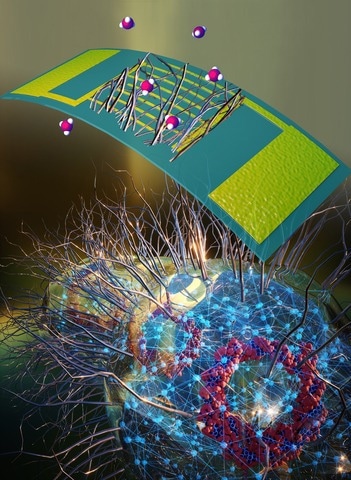Nanowires 10,000 times thinner than a human hair have been developed by researchers at the University of Massachusetts Amherst. These nanowires can be easily grown by common bacteria and are tuned to “smell” a wide variety of chemical tracers, including those released by people with various medical conditions, such as asthma and kidney disease.
 Specific molecules stick to nanowires grown on genetically modified E. coli. Image Credit: UMass Amherst
Specific molecules stick to nanowires grown on genetically modified E. coli. Image Credit: UMass Amherst
The ability to stack thousands of these finely tuned wires, each sniffing out a different chemical, onto small, wearable sensors gives healthcare professionals a new tool for keeping track of possible health complications. As microbes are used to generate the wires, they are organic, biodegradable, and far greener than any inorganic nanowire.
Senior authors Derek Lovley, Distinguished Professor of Microbiology at UMass Amherst, and Jun Yao, Professor of Electrical and Computer Engineering in the College of Engineering at UMass Amherst, needed to look no further than their noses to end up making these breakthroughs, which were described in the journal Biosensors and Bioelectronics.
Human noses have hundreds of receptors, each sensitive to one specific molecule. They are vastly more sensitive and efficient than any mechanical or chemical device that could be engineered. We wondered how we could leverage the biological design itself rather than rely on a synthetic material.
Jun Yao, Study Senior Author and Professor, Electrical and Computer Engineering, College of Engineering, University of Massachusetts, Amherst
The team questioned if they could use nature to detect disease, and they have successfully done so.
The solution starts with a Geobacter sulfurreducens bacterium, which Lovley and Yao previously utilized to build a biofilm capable of generating long-term, continuous electricity from human sweat. Surprisingly, G. sulfurreducens’s capacity to naturally produce small, electrically conductive nanowires is remarkable.
It is challenging to employ G. sulfurreducens at scale since it is a finicky bacterium that requires particular conditions to flourish.
What we have done is to take the ‘nanowire gene’—called pilin—out of G. sulfurreducens and splice it into the DNA of Escherichia coli, one of the most widespread bacteria in the world.
Derek Lovley, Study Senior Author and Distinguished Professor, Microbiology, University of Massachusetts, Amherst
By removing the pilin gene from G. sulfurreducens, Lovley, Yao, and his colleagues altered it to contain a specific peptide known as DLESFL that is incredibly sensitive to ammonia—a chemical frequently found in the breath of people with kidney disease.
The genetically engineered strain of E. coli produced small nanowires bristling with the ammonia-sensing peptide when the modified pilin gene was spliced into its DNA. The group then created a sensor out of these ammonia-sensitive nanowires.
Genetically modifying the nanowires made them 100 times more responsive to ammonia than they were originally. The microbe-produced nanowires function much better as sensors than previously described sensors fabricated with traditional silicon or metal nanowires.
Yassir Lekbach, Study Co-Lead Author and Postdoctoral Researcher, Microbiology, University of Massachusetts, Amherst
These new sensors are not required solely to detect renal disease and ammonia.
Toshiyuki Ueki, the study’s other co-lead author and research professor in microbiology at UMass Amherst, added, “It is possible to design unique peptides, each of which specifically binds a molecule of interest. So, as more tracer molecules emitted by the body and which are specific to a particular disease are identified, we can make sensors that incorporate hundreds of different chemical-sniffing nanowires to monitor all sorts of health conditions.”
A New Paradigm for Electrical Engineering
As carbon nanotubes are inherently carcinogens, conventional silicon or carbon fiber nanowires can be highly poisonous and end up as non-biodegradable e-waste. Its raw materials can significantly negatively impact the environment and need vast quantities of energy and chemical inputs to gather and produce. However, Lovley and Yao’s nanowires are far more sustainable because they are made from common bacteria.
Yao further stated, “One of the most exciting things about this line of research is that we are taking electrical engineering in a fundamentally new direction. Instead of wires made from scarce raw resources that won’t biodegrade, the beauty of these protein nanowires is that you can use life’s genetic design to build a stable, versatile, low impact and cost-effective platform.”
The Institute for Applied Life Sciences (IALS) at UMass Amherst, which brings together in-depth and interdisciplinary expertise from 29 departments to translate fundamental research into innovations that improve human health and well-being, supported this research with funding from the National Science Foundation.
Journal Reference
Lekbach, Y., et al. (2023) Microbial nanowires with genetically modified peptide ligands to sustainably fabricate electronic sensing devices. Biosensors and Bioelectronics. doi:10.1016/j.bios.2023.115147.